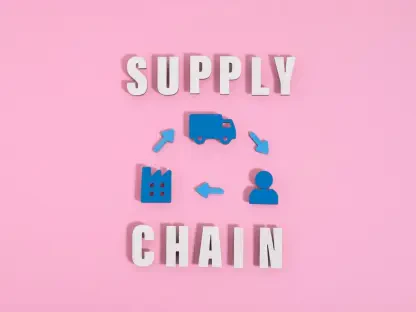In an era where digital transactions dominate consumer behavior, Postes Canada, the backbone of the nation’s postal system, has reported a staggering 200% surge in parcel volumes, driven by the unrelenting rise of e-commerce. This dramatic increase reflects a broader transformation in how Canadians shop, with online platforms becoming the go-to for everything from daily essentials to holiday gifts. Such a shift poses both unprecedented opportunities and significant challenges for a traditional postal service adapting to a digital landscape. This report delves into the factors fueling this growth, the operational hurdles faced, and the future trajectory of postal services in Canada amidst an ever-evolving retail environment.
The Rise of E-Commerce and Its Impact on Postal Services
The postal industry in Canada, with Postes Canada at its helm, has long served as a critical link in national communication and commerce. As the primary service provider, Postes Canada handles millions of parcels and letters annually, maintaining a vast network that spans urban centers and remote regions alike. However, the industry is undergoing a profound shift as digital platforms reshape consumer expectations, pushing postal services to prioritize speed and efficiency over traditional mail delivery.
A significant driver of this change is the global and local boom in online shopping. In Canada, e-commerce has surged as consumers increasingly favor the convenience of digital marketplaces, a trend accelerated by changing lifestyles and the need for contactless transactions. This has led to an exponential rise in demand for parcel delivery, positioning postal services as essential cogs in the retail supply chain, far beyond their historical role.
Key players such as Amazon, Walmart, and Shopify have further amplified this demand, partnering with or competing against postal services to meet consumer needs. These e-commerce giants, alongside a growing array of smaller online retailers, have created a dynamic ecosystem where delivery speed often defines customer satisfaction. Additionally, technological advancements like real-time tracking, automated sorting systems, and mobile apps for delivery updates are being integrated into Postes Canada’s operations, modernizing the service to keep pace with market demands.
Understanding the 200% Volume Surge at Postes Canada
Key Trends Driving the Growth
At the heart of Postes Canada’s reported 200% volume surge lies the explosive growth of e-commerce, which has fundamentally altered consumer purchasing habits. Canadians are not just buying more online; they are diversifying their purchases across categories, from electronics to groceries, expecting swift and reliable delivery. This behavioral shift has turned parcel delivery into a cornerstone of the postal business, far outpacing traditional letter mail.
Seasonal peaks, particularly during the holiday shopping period, have intensified this demand. Events like Black Friday and Christmas shopping sprees create massive spikes in order volumes, testing the limits of postal infrastructure. These periods highlight the need for robust planning and resource allocation to prevent delays and maintain service quality under pressure.
Emerging delivery technologies have played a pivotal role in enabling Postes Canada to manage these higher volumes. Innovations such as automated parcel lockers, optimized routing software, and data analytics for demand forecasting have enhanced operational efficiency. These tools allow the postal service to scale up during peak times while striving to meet evolving customer expectations for faster and more transparent delivery processes.
Data and Projections for Postal Growth
Concrete data underscores the scale of Postes Canada’s growth, with the 200% volume surge representing a dramatic leap compared to baseline figures from just a few years prior. While exact numbers may vary by region, internal reports suggest that parcel deliveries have more than doubled in key urban markets, reflecting a nationwide trend. This growth correlates directly with the rise in online retail transactions logged over recent years.
Market performance indicators further illustrate the impact of this surge. Delivery times, though occasionally strained during high-demand periods, have largely remained competitive due to strategic investments in logistics. Customer satisfaction metrics also show a positive trend, with many appreciating enhanced tracking options and flexible delivery choices, though areas for improvement persist during peak seasons.
Looking ahead, forecasts suggest continued growth in parcel volumes, with e-commerce expected to expand further from the current year through 2027. Analysts predict that sustained digital adoption and potential market expansion into underserved rural areas could drive even higher demand. These projections emphasize the need for ongoing innovation to maintain service levels amid an increasingly digital economy.
Challenges in Managing Rapid Volume Increases
The sudden spike in demand has presented significant operational challenges for Postes Canada, particularly in terms of capacity constraints. Existing infrastructure, designed for a different era of mail delivery, often struggles to accommodate the sheer number of parcels flooding the system. This has led to bottlenecks in sorting facilities and delays in last-mile delivery in some regions.
Labor shortages exacerbate these issues, as the rapid increase in workload requires additional staffing that is not always readily available. Seasonal hiring helps, but training and retention remain hurdles, especially in a competitive job market where private logistics firms offer attractive alternatives. Addressing these gaps requires strategic workforce planning and investment in employee support systems.
Market competition from private logistics companies adds another layer of complexity. Firms like FedEx and UPS, with their agile operations and global reach, challenge Postes Canada’s market share, particularly in urban centers. To counter this, potential strategies include forging partnerships with e-commerce platforms for exclusive delivery contracts or investing in cutting-edge technology to streamline operations and reduce costs over time.
Regulatory and Operational Frameworks for Postal Services
The regulatory environment governing postal services in Canada shapes much of Postes Canada’s operational scope. Policies on pricing, delivery standards, and universal service obligations ensure that the postal service remains accessible to all Canadians, regardless of location. These regulations, while critical for equity, sometimes limit flexibility in responding to market-driven demands for speed and cost efficiency.
Compliance with safety, security, and data protection standards is equally vital in parcel handling. With increased volumes come heightened risks of loss, theft, or data breaches related to customer information. Postes Canada must adhere to strict guidelines to safeguard parcels and personal data, necessitating robust systems for tracking and accountability across the delivery chain.
Potential regulatory changes or government support could significantly influence future operations. For instance, subsidies for infrastructure upgrades or relaxed pricing controls might enable Postes Canada to better manage growth. Conversely, stricter environmental regulations could push for greener delivery methods, adding costs but aligning with broader sustainability goals. Navigating this framework will be crucial for sustained expansion.
Future Outlook for Postes Canada in the E-Commerce Era
Emerging technologies hold transformative potential for the future of postal services in Canada. Automation in sorting centers, coupled with experimental drone delivery systems, could drastically reduce operational costs and improve delivery times, especially in remote areas. Such advancements, if scaled effectively, might redefine how Postes Canada operates in a competitive landscape.
Market disruptors, however, loom on the horizon. New competitors, including tech-driven startups offering hyper-local delivery options, could fragment the market. Additionally, shifts in consumer preferences toward same-day delivery or subscription-based models might pressure traditional postal services to adapt rapidly. Staying ahead will require agility and a willingness to embrace unconventional partnerships or service models.
Growth areas such as expanded rural delivery networks and international shipping present significant opportunities. With global trade on the rise, Postes Canada could leverage its established infrastructure to capture a larger share of cross-border e-commerce deliveries. Economic conditions will play a role, but strategic focus on these segments could solidify the postal service’s position as a leader in the evolving logistics sector.
Conclusion: Navigating Growth in a Digital Landscape
Reflecting on the journey, the 200% volume surge at Postes Canada marked a turning point, highlighting how e-commerce reshaped the postal landscape with unparalleled demand. The operational strides made through technology and infrastructure investments demonstrated resilience, while challenges like capacity limits and competition underscored the complexity of rapid growth. For stakeholders, the path forward involves actionable steps such as prioritizing scalable logistics solutions and exploring collaborative ventures with e-commerce giants to enhance delivery networks. Further consideration of government-backed initiatives for rural expansion offers a way to bridge service gaps, ensuring that growth remains inclusive and sustainable in an increasingly digital world.









